
Animals that prowl on mountaintops and the surrounding wilderness are usually some of our largest land predators. Still, there are fascinating smaller creatures and pretty epic plant life on their dizzying heights as well. Let’s discover twelve animals that prowl atop Maryland’s tallest mountain and the flora that supports the ecosystems.
What’s Maryland’s Tallest Mountain?
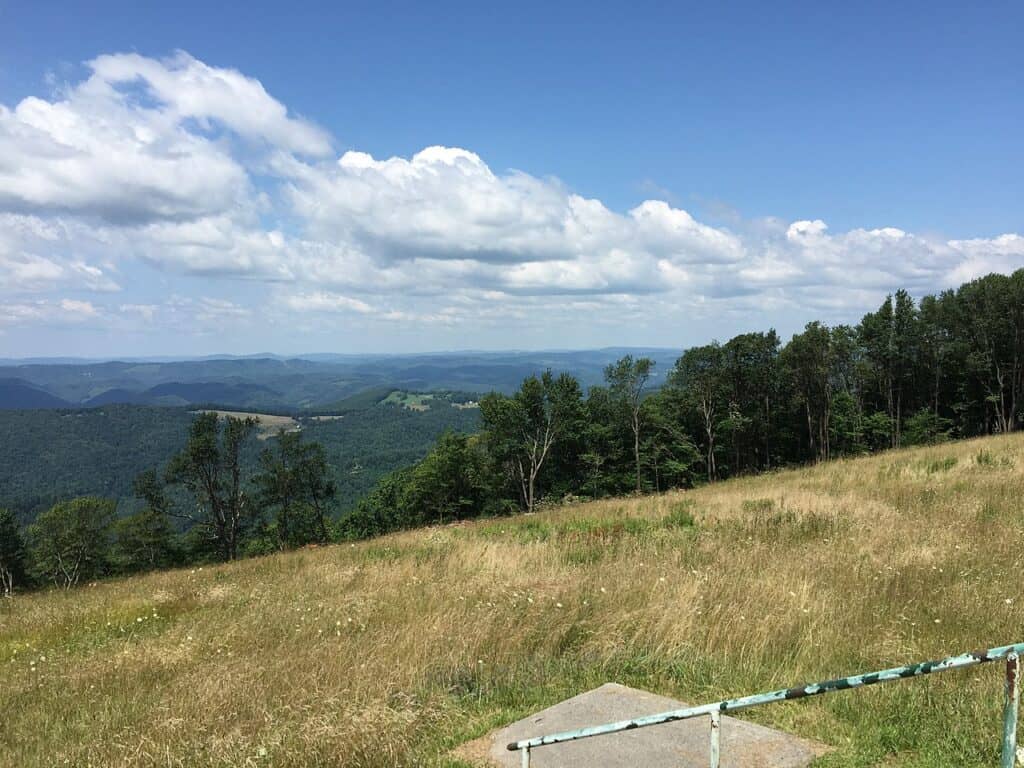
The tallest point in Maryland is Hoye Crest on Backbone Mountain.
The tallest mountain in Maryland is privately owned Hoye Crest on Backbone Mountain, just over the border from West Virginia. It peaks at a wind-whipping 3,360 feet. Named after Captain Charles E. Hoye, the spot is well-marked with a plaque and picnic benches. “Highest peakers” like to tick this one off the bucket list because it’s challenging but not insurmountable to average trekkers.
Backbone Mountain is set in Potomac State Forest, an 11,535-acre forest packed with exciting wildlife taking advantage of the forests, streams, rivers, and craggy, rocky outcrops. This epic background to Maryland’s tallest mountain surrounds Maryland High Point Trail, the only approved trail to the top.
That’s the setting for our incredible wildlife list, so let’s jump in and find out what is prowling, flying, and swimming up there.
1. Bobcat
Bobcats live around Maryland’s highest point. Their preferred habitat is forested areas with lots of tree cover and small prey such as rabbits, squirrels, mice, and, on occasion, deer fawns. A bobcat is roughly twice as large as a domestic cat but without a pet cat’s tail. Tufted ears and a ruff of facial fur heighten a bobcat’s hearing and also gives them a mega cute appearance, especially the kittens. However, it’s not a good idea to approach a bobcat because they’re fearsome predators for their size.
These epic felines hunt during the evening, meaning they’re crepuscular. To capture prey, this stealthy cat stalks and hides in the bushes, leaping out and pouncing on their unfortunate dinner. Their tawny brown, white, black, red, and beige coats provide excellent camouflage in forest environments. Not much escapes a bobcat.
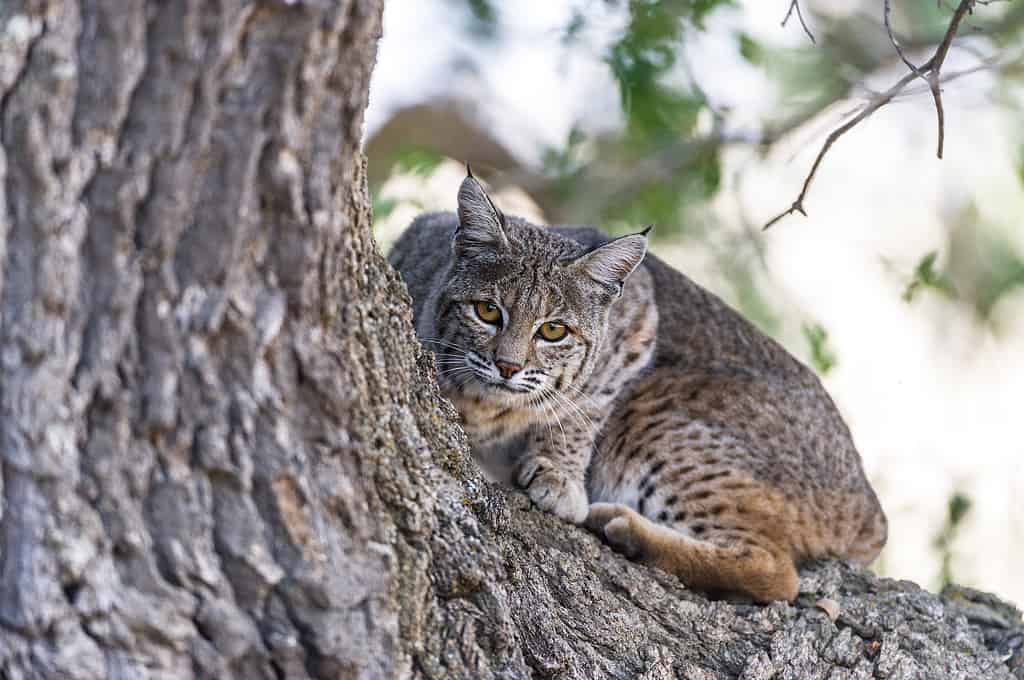
Bobcats are named for their short, bobbed tails.
©iStock.com/brentawp
2. Copperhead Snake
One of only two venomous snakes in Maryland (the other being the timber rattlesnake), copperhead snakes get their name from the red-brown head patch.
These snakes are heavy and can reach 20-36 inches long. They’re particularly good at camouflage because their coppery-red hourglass crossbands are virtually invisible once settled down in leafy litter. They’re not human hunters, but if they’re scared or trod on, they strike and inject painful venom. Their chief prey of frogs, mice, salamanders, birds, and small snakes receive an incapacitating bite, and then a copperhead swallows them whole.
Copperheads reside in river valleys, swamps, forests, wooded slopes, and rocky outcrops. Maryland’s tallest point and the surrounding forests provide perfect habitats. Keep dogs on a leash and your eyes peeled.
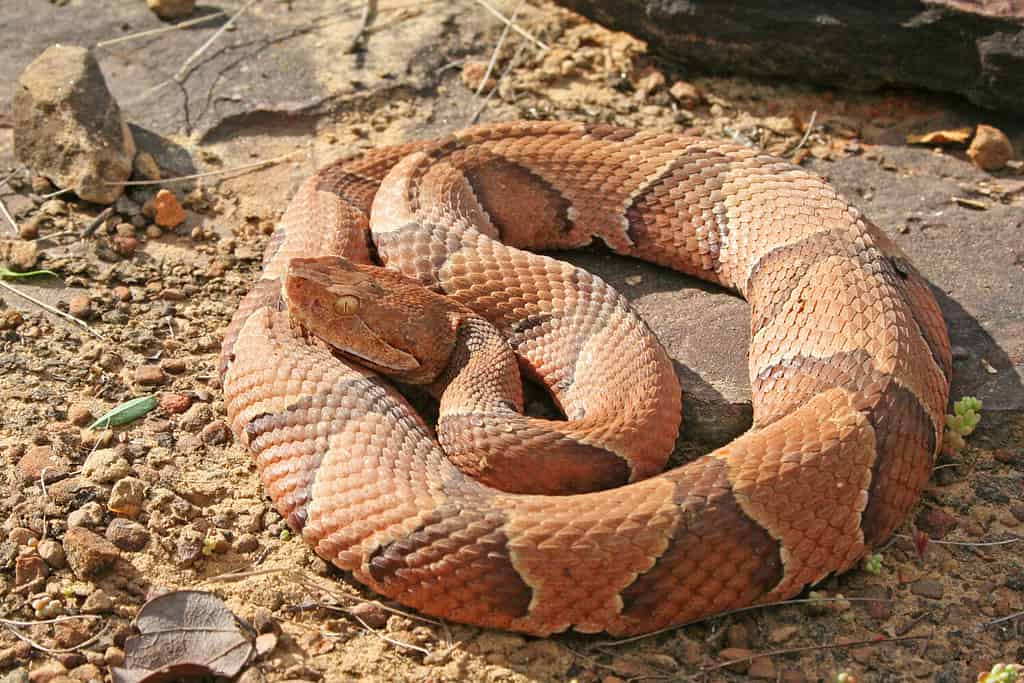
Copperhead snakes are one of only two venomous snakes in Maryland.
©Creeping Things/Shutterstock.com
3. Coyote
Coyote packs reside in forested areas surrounding Maryland’s tallest mountain, but it’s not often hikers spot them because they are nocturnal and naturally shy of humans.
Similar in appearance to the gray fox, coyotes prey on mice, rabbits, and small deer but eat most animals, including amphibians, reptiles, and carrion too. Coyotes run at 40 mph, have golden eyes, and emit a spine-chilling howl at night. A target for hunters and myth writers, coyotes have managed to expand their ranges, taking advantage of urban settlements and thick forests.

Coyotes hunt in packs at night, searching out rabbits, mice, and deer.
©Warren Metcalf/Shutterstock.com
4. Little Brown Bat
The little brown bat inhabits tree hollows, caves, rocky outcrops, and Maryland’s tallest mountain tunnels. Nocturnal echolocation hunters, this furry bat is one of the United States’ most common bats, but it’s listed as vulnerable by Maryland’s Department of Natural Resources.
Using their echolocation abilities, little brown bats prey on nighttime insects such as juicy moths and pond water skimming bugs. Although they look cute, this bat can eat 1,000 mosquitoes in one night. Thank you, little brown bat.
When it’s not hunting, a little brown bat spends time grooming its golden-red brown fur. Each individual stands 2-4 inches long, but their wingspan stretches 8-11 inches. Up to 10,000 of these mosquito hunters live in colonies, but you won’t spot one unless you’re hiking at sunset.

Little brown bats hunt moths, insects, and mosquitoes using echolocation.
©Peter Radosa/Shutterstock.com
5. Peregrine Falcon
The world’s fastest animal swoops and stalks Maryland’s skies. Magnificent peregrine falcons reach 200 mph when they dive for their bird prey, which is chiefly pigeons and ducks, but sometimes smaller songbirds. This speedy bird of prey catches unlucky prey mid-flight to avoid breaking bones in a ground collision.
Hikers can identify peregrine falcons by their gray-brown feathers, barred undersides, yellow legs, hooked beak, and black tear marks. Typically, an adult measures 1-2 feet in body length with a wingspan of four feet but only weighs 2-3 lbs. They patrol Maryland’s skies and every continent on Earth except Antarctica.
The fastest recorded peregrine dive reached 242 mph; no bird can outrun it. Pigeons or duck in mid-flight just don’t stand a chance. Watch Maryland’s tallest peak for this top predator’s outline.

A peregrine falcon captures pigeons mid-flight to avoid breaking its bones in a 200 mph ground collision.
©iStock.com/rancho_runner
6. Red-tailed Hawk
Another epic bird of prey circling Maryland’s tallest mountain is the United States’ most common falcon, the red-tailed hawk. Recognizable by its reddish-brown fanned tail, this hunter preys on rodents, lizards, snakes, rabbits, and any animal it can swoop on and pin to the ground. This feisty bird is known to take on much larger birds of prey that might want to invade its territory.
Red-tailed hawks reach 120 mph when they dive, and they can spot a mouse from 100 feet in the air. Their superb eyesight picks out ground-based prey with ease.
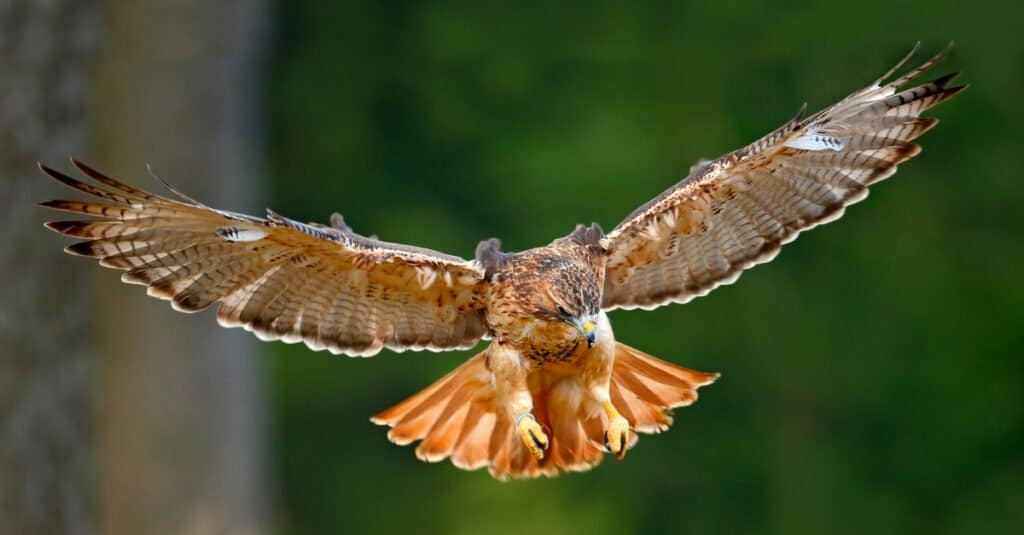
Red-tailed hawks can spot rodents from 100 feet in the air.
©Ondrej Prosicky/Shutterstock.com
7. Gray Fox
Omnivorous gray foxes live in thick forests next to more open areas such as plains and fields because these areas are home to their rodent, bird, berry, and nut prey. Potomac State forest’s gray foxes hunt at dusk and throughout the night, climbing trees with their retractable cat-like claws and athletically pouncing on ground-based creatures.
Chiefly 30-44 inches long, gray foxes tend to reach shorter proportions than red foxes. The largest males weigh up to 15 lbs, and although they’re gray with white chest and belly areas, many display red, brown, yellow, and white patches too.
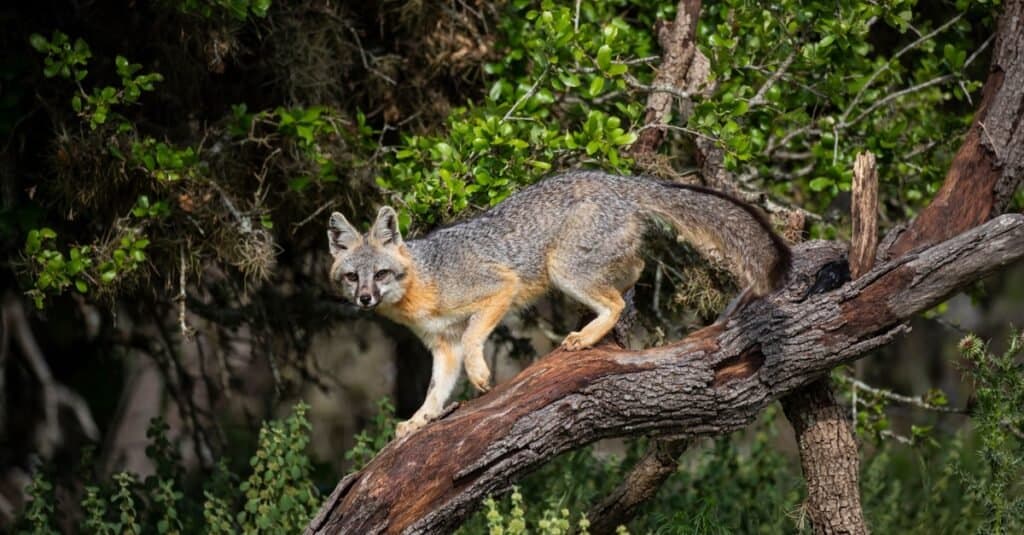
Gray foxes have retractable claws, so they’re able to climb trees.
©Danita Delimont/Shutterstock.com
8. Trout
Rivers in the Potomac State Forest surround Maryland’s tallest mountain. Hoye Crest provides clean habitats for several trout species, but anglers need a freshwater license to catch them.
Brown, pink, and silver speckled or striped trout reach 40 lbs and swim at eight mph. Adult trout have long oval bodies and large mouths. A distinctive dorsal fin tops their back. They prey on other fish and aquatic animals but aren’t averse to swallowing rodents that fall into the water.

Trout thrive in clean, cold water and provide food for numerous Maryland animal species.
©United States Fish and Wildlife Services / Public domain – Original / License
9. Wild Turkey
Hardwood forests and clearings of Maryland’s tallest mountain are home to magnificent gobbling wild turkeys.
This North American native bird forms flocks to forage on the ground and roosts in thick tree cover. Unmissable with their loud vocalizations and bronze-gold and purple feathers topped by red necks, heads, and wattles, clever wild turkeys often forage alongside deer and squirrels to increase their chances of predator detection.
Females build ground nests by digging a slight depression in the soil; then, she covers it with twigs. She lays eggs on the twigs, incubates them, and looks after poults. Females generally weigh eight lbs, whereas males can reach 24 lbs. Despite their size and weight, and unlike domestic turkeys, wild turkeys are powerful fliers.
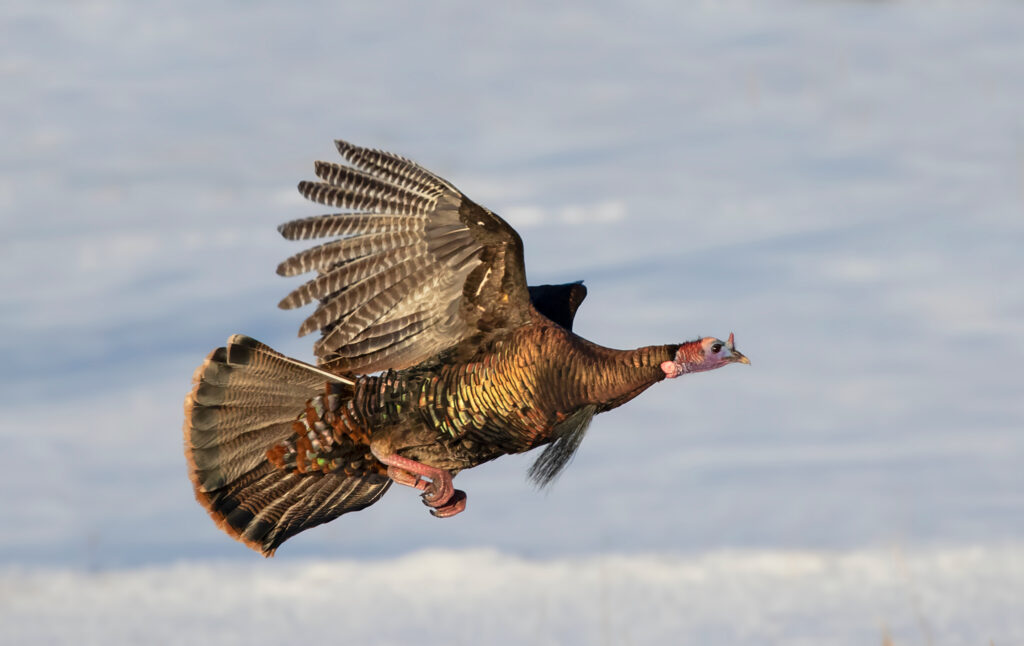
Unlike domestic turkeys, wild turkeys are excellent fliers and use their ability to evade predators.
©Jim Cumming/Shutterstock.com
10. White-tailed Deer
White-tailed deer live in forested areas of Maryland’s tallest mountain, leaving the safety of the woods to forage in open spaces. They’re herbivores that graze almost constantly on grasses, flowers, buds, mosses, and tree bark in winter’s lean months.
Fairly small in size, they generally reach 1.7 to 3.9 feet tall. White-tailed deer get their name from their white tails, which they raise up when startled and run for cover at up to 30 mph. Their chief predators in Maryland include hunters, bobcats, black bears, and coyotes.
Males grow annual antlers and shed them in the fall. Hikers might spot shed antlers on Hoye Crest’s footpath and pasture edges. They’re a huge hit with children.
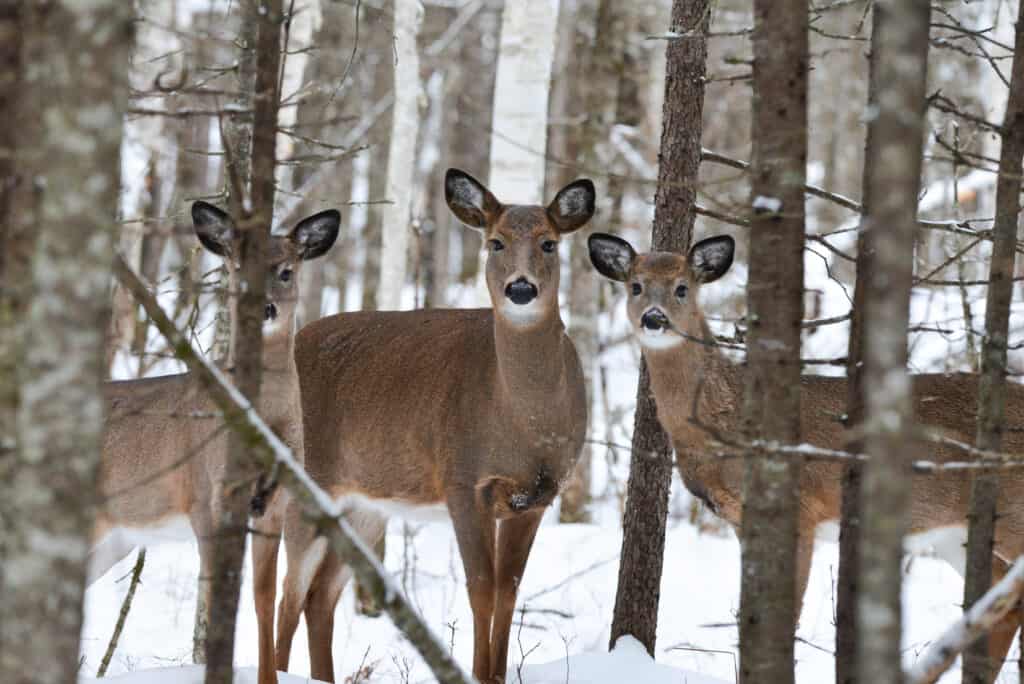
White-tailed deer can run at 30 mph to evade predators.
©Rebecca C. Photography/Shutterstock.com
11. Ovenbird
Pretty singing ovenbirds are small songbirds in the Warbler family. Their incredibly loud song “tee-cha TEE-CHA” is unmissable, but their plumage is designed for forest floor camouflage. Their olive-brown feathers display black streaks and a white breast with an orange head stripe perfect for woodland environments as they long-step the forest floor hunting down insects and larvae.
This songbird migrates to Central America in winter and returns to North America in spring to breed.
And its name, ovenbird? It’s nothing to do with how tasty they might be but refers to their oven-shaped nests, including a large hood. Built on the forest floor or tree branches, a female will feign injury to lure predators away from her nest.
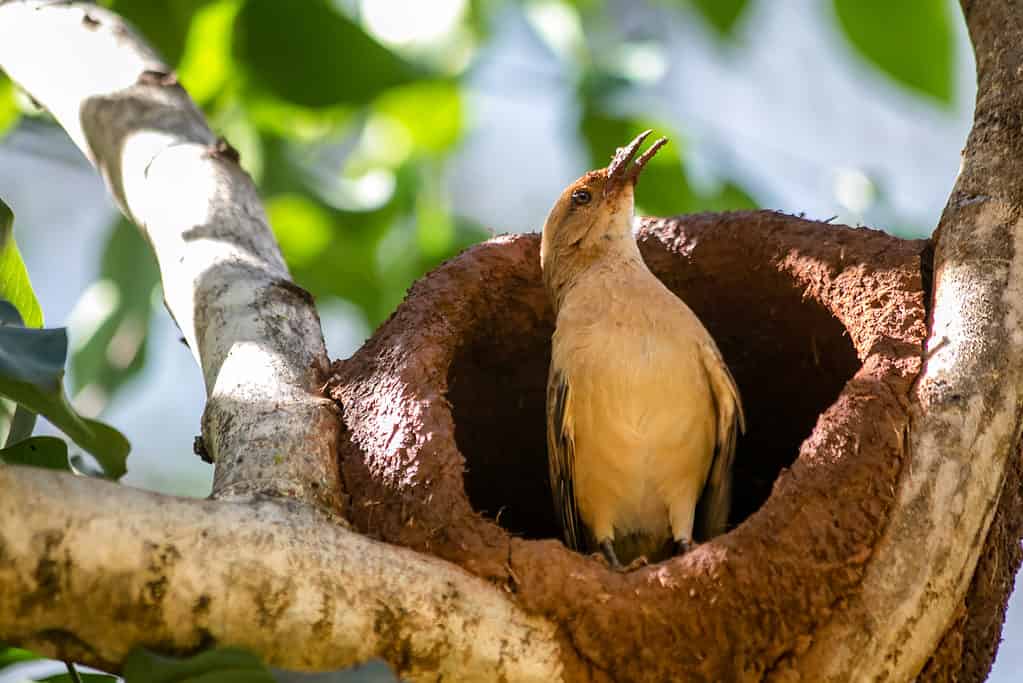
Female oven birds build a distinctive oven-shaped nest and feign injury to lure predators away.
©Fernando Calmon/Shutterstock.com
12. Black Bears
Black bears roam for miles around Maryland’s tallest mountain, searching out fruit, berries, and nuts and preying on deer. They range from brown to dark red, black, and even tan. Heavily built and covered in thick fur, black bears have a pointed muzzle, small eyes, and an excellent sense of smell.
Their powerful limbs and sharp claws mean they can easily climb trees to strip berries and vegetation. Solitary creatures, they spent most of their waking hours searching out enough food to see them through winter’s semi-hibernation.
These medium-sized bear species isn’t a common sight, but they can be aggressive toward human and dogs.
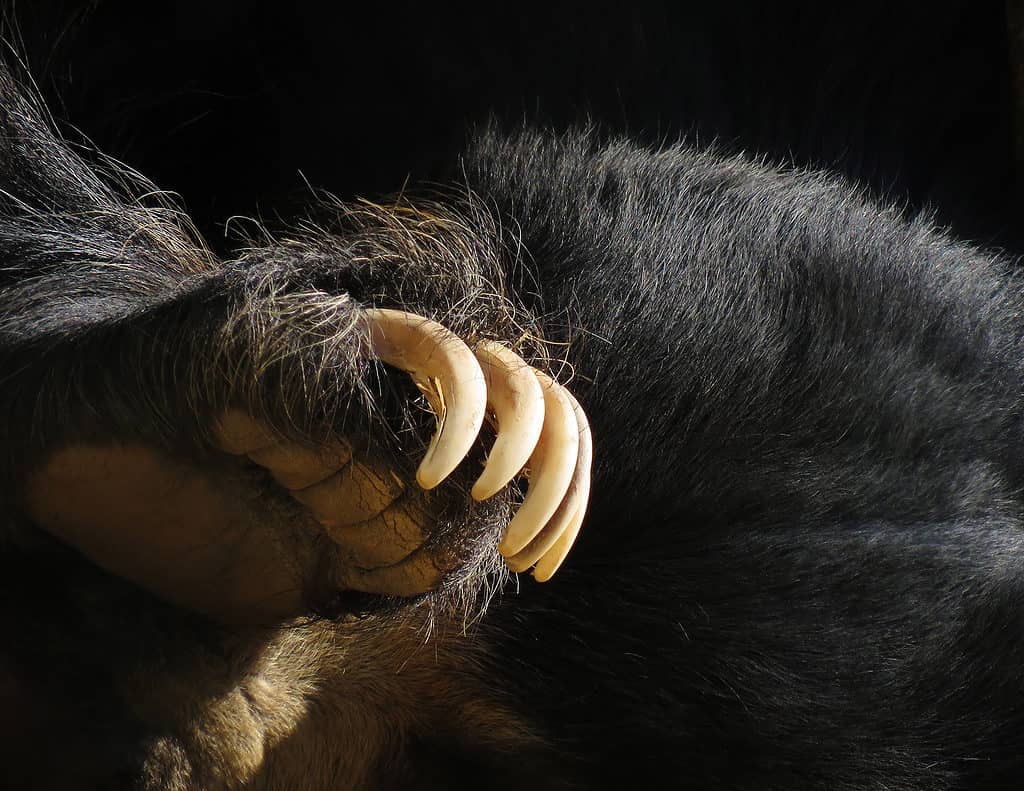
Black bears have powerful limbs and sharp claws so that they can climb trees.
©iStock.com/Derikjohn
What Plants Grow on Maryland’s Tallest Mountain?
Hoye Crest on Backbone Mountain is lush with a hardwood forest. Trekkers will spot mixed oaks, red maples, sugar maples, basswood, birch, and ash, but the peak is more barren due to wind strength and snowfall.
However, in spring, mountain avens and toxic jack-in-the-pulpit bloom there. Further down the peak, numerous ferns enjoy the green canopy of bush honeysuckle, and triphylums abound alongside blueberry thickets.

Pretty mountain avens form mats of color near the peak of Maryland’s tallest mountain.
©iStock.com/Michel VIARD
Incredible Animals on Maryland’s Tallest Mountain
Hoye Crest on Backbone Mountain is Maryland’s tallest point. The surrounding area is lush with various ecosystems that support many beautiful creatures. This diverse ecosystem supports wide-ranging animals from top predators like black bears, copperheads, bobcats, and coyotes, to speedy trout, vivid wild turkeys, loud ovenbirds, and lofty peregrine falcons.
Hikers hoping to catch sight of Hoye Crest’s amazing wild creatures should wear sturdy shoes and dress appropriately for the weather. Thermals and waterproofs are essential in winter, and water plus sunscreen and a hat in summer. Don’t forget bear spray and keep your dog on a lead, just in case.
Summary of 12 Animals That Prowl Atop Maryland’s Tallest Mountain
| Animal | Fun Fact | |
|---|---|---|
| 1 | Bobcat | It’s twice as big as a domestic cat and has tufted ears |
| 2 | Copperhead Snake | One of only two venomous snakes in Maryland |
| 3 | Coyote | They live in packs and are famous for their howls |
| 4 | Little Brown Bat | Can eat 1,000 mosquitoes in one night |
| 5 | Peregrine Falcon | Can reach 200 mph when diving for prey |
| 6 | Red-tailed Hawk | Can spot a little mouse from 100 feet in the air |
| 7 | Gray Fox | These little foxes have retractable cat-like claws |
| 8 | Trout | They thrive in clean, cool, waters |
| 9 | Wild Turkey | Unlike domesticated turkeys – wild turkeys can fly |
| 10 | White-tailed Deer | Males grow and shed antlers annually |
| 11 | Ovenbird | Their nests are shaped like an oven |
| 12 | Black Bears | They can climb trees with ease |
The photo featured at the top of this post is © Brian M. Powell (user Bitmapped on en.wikipedia) / CC BY-SA 3.0 – License / Original
Thank you for reading! Have some feedback for us? Contact the AZ Animals editorial team.







